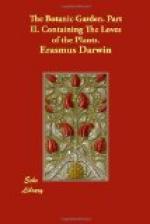Amphibious
Nymph, from Nile’s prolific bed
200 Emerging TRAPA lifts her pearly head;
Fair
glows her virgin cheek and modest breast,
A
panoply of scales deforms the rest;
[Trapa, l. 200. Four males, one female. The lower leaves of this plant grow under water, and are divided into minute capillary ramifications; while the upper leaves are broad and round, and have air-bladders in their footstalks to support them above the surface of the water. As the aerial leaves of vegetables do the office of lungs, by exposing a large surface of vessels with their contained fluids to the influence of the air; so these aquatic leaves answer a similar purpose like the gills of fish; and perhaps gain from water or give to it a similar material. As the material thus necessary to life seems to abound more in air than in water, the subaquatic leaves of this plant, and of sisymbrium, coenanthe, ranunculus aquatilis, water crowfoot, and some others, are cut into fine divisions to increase the surface; whilst those above water are undivided. So the plants on high mountains have their upper leaves more divided, as pimpinella, petroselinum, and others, because here the air is thinner, and thence a larger surface of contact is required. The stream of water also passes but once along the gills of fish, as it is sooner deprived of its virtue; whereas the air is both received and ejected by the action of the lungs of land-animals. The whale seems to be an exception to the above, as he receives water and spouts it out again from an organ, which I suppose to be a respiratory one. As spring-water is nearly of the same degree of heat in all climates, the aquatic plants, which grow in rills or fountains, are found equally in the torrid, temperate, and frigid zones, as water-cress, water-parsnip, ranunculus, and many others.
In warmer climates the watery grounds are usefully cultivated, as with rice; and the roots of some aquatic plants are said to have supplied food, as the ancient Lotus in Egypt, which some have supposed to be the Nymphaea.—In Siberia the roots of the Butemus, or flowering rush, are eaten, which is well worth further enquiry, as they grow spontaneously in our ditches and rivers, which at present produce no esculent vegetables; and might thence become an article of useful cultivation. Herodotus affirms, that the Egyptian Lotus grows in the Nile, and resembles a Lily. That the natives dry it in the sun, and take the pulp out of it, which grows like the head of a poppy, and bake it for bread. Enterpe. Many grit-stones and coals, which I have seen, seem to bear an impression of the roots of the Nymphaea, which are often three or four inches thick, especially the white-flowered one.]




